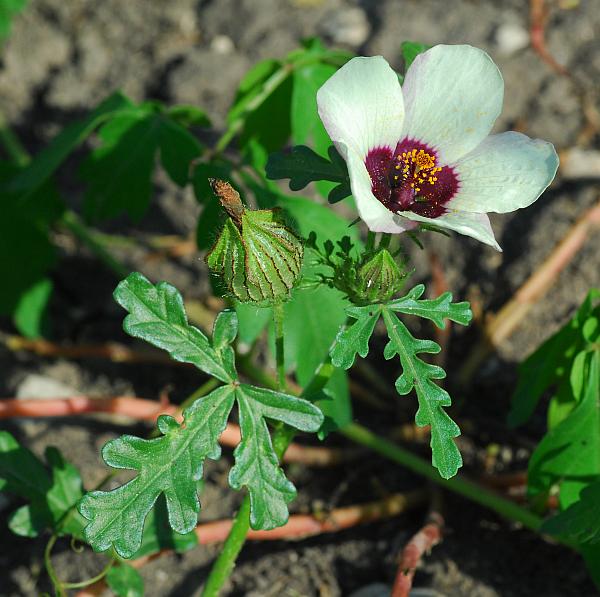Hibiscus trionum L.
Flower-Of-An-Hour

Introduced
CC = *
CW = 5
MOC = 52
© SRTurner
Hibiscus trionum L.Flower-Of-An-Hour | |
 |
Introduced CC = * CW = 5 MOC = 52 |
© SRTurner |
|
Family - Malvaceae Habit - Annual forb. Stems - Spreading to loosely ascending, to 55 cm, branching, moderately to densely hairy when young, many of the hairs appearing branched or fasciculate, becoming glabrous or nearly so with age, scabrous due to the swollen bases of the fasciculate hairs.
Leaves - Alternate, deeply divided, petiolate, stipulate. Blades 1-6 cm long, broadly ovate in outline, deeply 3-lobed, the main lobes often shallowly to deeply lobed again, the margins coarsely scalloped or bluntly toothed, the upper surface sparsely pubescent with simple and/or fasciculate hairs along the veins, the undersurface moderately pubescent with stellate and fasciculate hairs. Stipules persistent, attenuate, 3-7 mm long, with coarse long cilia on margins. Petioles to 3 cm.
Inflorescences - Solitary axillary flowers along the length of the stems and branches. Peduncles to 2.5 cm in flower, slightly longer in fruit, densely stellate-pubescent. Peduncle with an obvious joint in the apical 1/3. Pubescence beyond joint becoming long-ciliate and branching as well as stellate. Bractlets subtending the calyx 10-12(-15), 4-10 mm long, bristly pubescent especially along the margins with simple or fasciculate hairs.
Flowers - Calyces 9-12 mm long at flowering, becoming greatly enlarged to 16-22 mm, papery, and inflated at fruiting, the main veins raised and ridgelike, dark green to dark purple, bristly pubescent with simple or fasciculate hairs, the tissue between nerves papery and translucent. Petals 5, 1.5-4.0 cm long, pubescent externally, mostly glabrous internally, cream-colored to yellow with dark reddish purple bases. Stamenal column to 1.1 cm long, wine-colored, glandular, the glands wine-colored. Free portion of filaments to 3 mm long, sparsely glandular. Anthers yellow-orange, 1 mm long and broad. Style exserted just beyond the stamenal column, glabrous, whitish-translucent, 5-lobed at the apex. Stigmas 5, wine-colored, globose-capitate, 1 mm in diameter. Ovary green, ovoid, densely antrorse-pubescent, 4 mm long in flower, 3 mm in diameter, 5-locular. Placentation axile.
Fruits - Capsules encased in persistent, inflated calyx, 0.9-1.6 cm long, ovoid-cylindric to nearly globose, 5-valved, longitudinally dehiscing, hairy. Seeds 5-8 per locule, 2.0-2.5 mm long, broadly kidney-shaped to nearly, triangular in outline, the surface minutely warty and usually also with minute stellate hairs, dark brown or grayish black.
Flowering - June - September. Habitat - Pond margins, streambanks, crop fields, fields, gardens, roadsides, railroads, open disturbed areas. Also cultivated. Origin - Native to Europe. Lookalikes - None. Other info. - This striking species can be found throughout much of Missouri, though it is uncommon or absent in much of the southeastern third of the state. It is also found scattered throughout the continental U.S., but most commonly in a belt extending from eastern Kansas through the New England states. It is a very easily recognized species, with unique flowers and leaves. It is also unlike other Missouri hibiscuses in its sprawling habit. The plant is commonly called "Flower of an Hour" because the flowers only open fully for an hour or two per day. The plant does well in cultivation and is easily propagated from seed. Although it is a beautiful plant appropriate as a garden ornamental, it is introduced and should not be deliberately spread in wild areas. It can be a problem weed in crop fields. Photographs taken in Brown Summit, NC., 9-14-02 (DETenaglia); also at Marais Temps Clair Conservation Area, St. Charles County, MO, 8-2-2018 (SRTurner). |